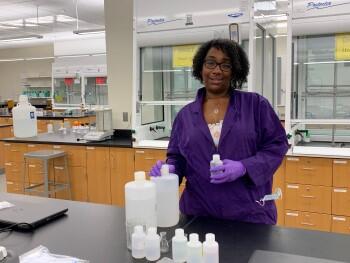
Nicole Gibbs knew she wanted to work in science after taking a Yale anatomy class through the Anatomy Teaching Program, a partnership between Yale University and Hill Regional Career High School. She eventually gravitated towards chemistry and landed a job as a laboratory assistant in the Department of Chemistry, a role she’s held for 16 years.
We checked in with Nicole at the Sterling Chemistry Laboratory to learn how she prepares the lab for students to conduct experiments.
Could you explain your role?
As a laboratory assistant for the undergraduate general chemistry teaching lab, I set up the lab for students to do experiments. I make chemicals, order supplies, and make sure the lab runs smoothly.
How do experiments in general chemistry differ from those done in organic chemistry under a fume hood?
In general chemistry, most of the time students are doing qualitative analysis. They’re adding a solution to another solution to see how much it takes to get a reaction, whether it’s equilibrium or just an acid-base titration.
Each semester focuses on different things. The fall is more lab technique so students can get used to doing it. And then the spring is more spectrometry, like experiments where they look at the color variations of M&M candy.
What’s involved in making chemicals in preparation for student lab experiments?
Most solutions I make are the addition of some solid into a known volume of water. Depending on how accurate it has to be, that determines which glassware I use.
I typically make large volumes of at least five liters at one time per experiment, and depending upon the experiment, I break it down into 125- or 500-ml bottles for each group of students. Depending on the group, it could be seven bottles per group. And in the fall, we can have up to eight groups.
How many classes and students are coming in per week?
We have two main classes, which is the 134 and 136 labs. There are also three different labs in the spring. Last semester, we had upwards of almost 300 students. Needless to say, that’s a lot of solution preparation.
Aside from mixing and distributing chemicals, what else do you put together for students to conduct an experiment?
Each experiment requires different things. Some weeks they use the computer and spectrometer, and some weeks it is the calorimeter.
One week is one whole experiment from Monday through Friday, unless it’s a two-week experiment. So every week they’re doing something different.
The students are assigned a drawer with a list of glassware. At the beginning of the week, they go through it to check they have everything they need to complete an experiment. If they need something during the week, I’m around to help with that.
What do you like to do for fun outside of work?
I have four children. You don’t get a lot of downtime having kids. My thing is I love reading. That’s my downtime.
Do you have a favorite genre that you like to read or a favorite book that you’re on right now?
I signed onto the urban fiction. That’s my genre choice. It’s usually black authors writing about street fiction. My very first book was Me and My Boyfriend by Keisha Ervin. That was her first novel, and after that, I read all her books.